Feeding poultry according to labor costs and cash costs is in the first place in the process of its breeding. In this regard, the selection of ready-made feeders must be approached with knowledge of the matter.
You can save money if you do it yourself. In addition to the material stimulus, you will receive moral and aesthetic pleasure, seeing how the chickens eat from the feeders made with their own hands.
Table of contents
Requirements
There are certain requirements for their manufacture:
- Strength: they must be made of a material that holds a certain shape, little or not deformed;
- Convenience in operation: it is convenient to clean, food can be easily filled in, and it is convenient for the bird to feed from it;
- The number of units must ensure the performance of its task - feed all livestock (if you put one small feeder for 50-100 heads, you can only imagine what will happen in the hen house);
- A feeder made of a specific material should be used. for a certain type of feed;
- She must be resilient (do not tip over or fall on its side from direct contact with the bird);
- Rational use (it is made in such a way as to make it impossible to enter litter and minimize the ingress of garbage).
- Is made not from harmful for feeding materials.
Types of homemade chicken feeders
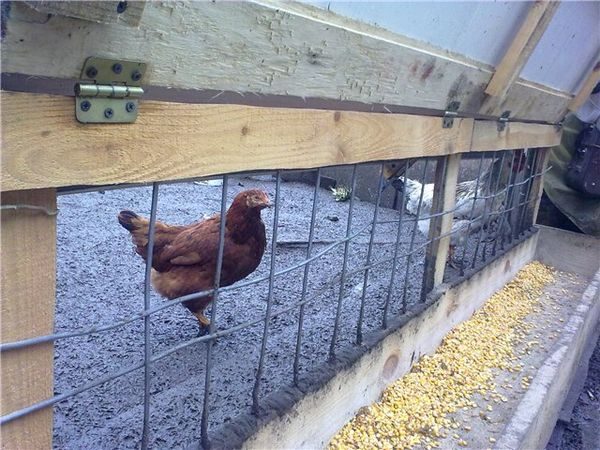
All feeders are classified according to the following criteria:
Depending on the method of feeding:
- bunker;
- gutter
Depending on the material from which they are made:
- wooden;
- solid metal;
- plastic;
- from metal mesh or rods:
- combined.
From plastic bottle
This model of the feeder is considered the easiest to manufacture. Easier is just put a bowl of food in the hen house.
Manufacturing techniques are as follows:
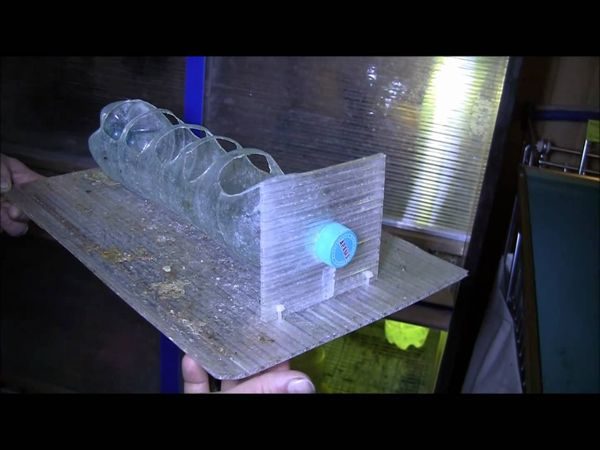
In 1.5 liter bottles, the bottom is cut (feed is poured through it) and we make holes closer to the neck around the perimeter so that grain is poured through it.
From the 2-liter bottles, the bottom is also cut, but the sides are left at a height of 10 cm (they cover the bottles containing food, against rain, other moisture and ingress of foreign bodies). 5-liter bottles are cut so that the distance from the cut line to the bottom is not more than 15 cm.
In the center of the cut tanks make a hole in the diameter of the neck of 1.5 liters. the bottle.In the 50x30 plywood sheet we also make holes in the diameter of 1.5 liters. the bottle. It remains for us to lower the 1.5 liter bottle in a container of larger diameter so that the neck goes through 2 openings and leaves the bottom of the plywood piece.
Further, it twists the cap from the bottom. In 1.5 l. The feeder is ready.
From a 5 liter plastic bottle
Feeder do in different ways. The easiest is to cut a small diameter hole around the bottom perimeter that is sufficient to spill the grain, another type of dry food; in the bottle itself you can pour the grain through a watering can inserted into the neck. From the bottom we substitute any vessel.
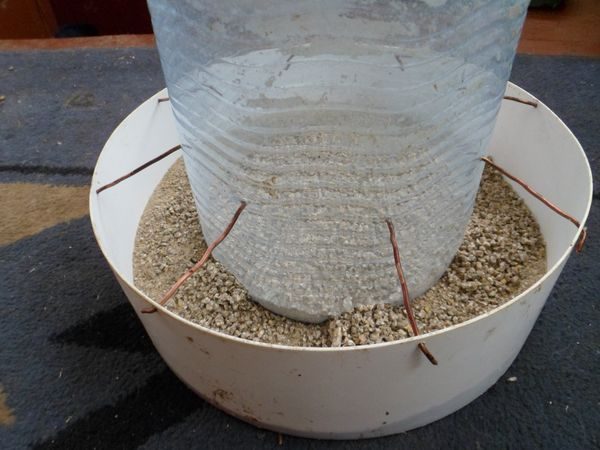
In the process of eating grain will pour through the holes in a substituted vessel. It can be made in another way: in the same container we cut small squares of such size around the perimeter so that the chicken can freely stick its head inside and peck up the grain. With this option, do not even need a plate as a pallet.
But if you need to tighten the structure, make it more massive, screw a piece of plywood to the bottom of the bottle. This prevents the bottle from tipping over if the feed supply is running out.
How to make a bunker bird feeder
The above-described methods for the manufacture of plastic troughs are also a kind of bunker troughs, but without a feed control mechanism.
An improved version of the bunker trough is done this way:
Plywood is cut into several pieces:
- front of the bunker - 40x50 cm;
- rear part - 40x40 cm;
- 2 side walls conical shape to connect the front and rear walls;
- opening up cap slightly larger than the size of the upper part of the bunker.
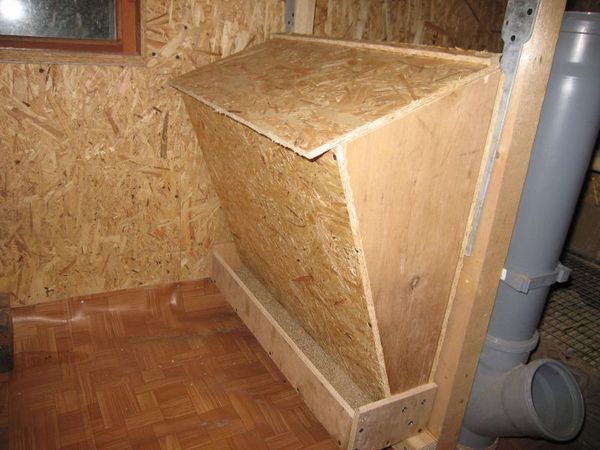
A slot is left at the bottom of the bunker for spilling food into a tray for eating by birds. As the feed is eaten by chickens, the level of feed in the bunker is lowered. It is easy to fill up.
To do this, open the lid and fill the required amount. It will be improved by making a grain feed adjustment mechanism at the bottom. The principle of its operation is to reduce the size of the slot (s) or increase it depending on the structure of the feed. This type of feeder attached both indoors and outdoors.
Auto-feeder and drinking bowl from sewer pipe
It can be made from plastic PVC sewer pipe. Better if you take the average diameter - 15 centimeters. In addition, for the arrangement will need two plugs and a tee. The length we choose such what is needed. Two pieces of a length of 20 centimeters and 10 centimeters are cut off the pipe.
Then they interconnect with a tee the longest and 20-centimeter sections of the pipe, set at the ends of the cap. A 10-centimeter piece of pipe is connected to the branch of the tee - this will be a feed tray.
Feed (or water in the case of the auto-drinker) and fix it on the wall of the chicken coop with the long side to the top.
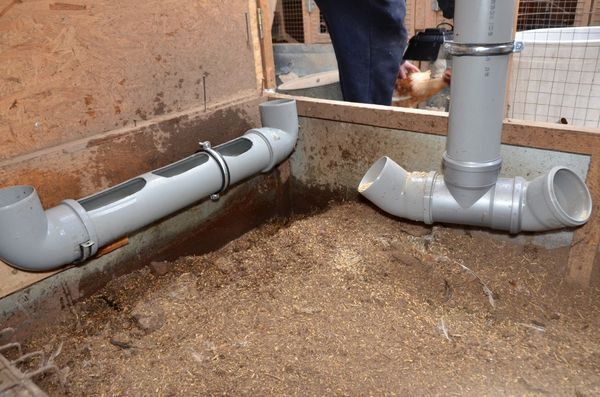
Some offer the following version of a self-made construction from scrap materials: At the bottom of the pipe, holes are drilled on both sides, expanding them to a diameter of 70 millimeters, so that birds have free access to feed. A stub is put on one side of the pipe, and the second segment is attached with a knee at a right angle. Feed is poured into it and a second plug is placed. You can also make an automatic drinker.
In our opinion, such a feeding trough has a very big drawback: as the bird eats itself, the feed will not be able to move along the pipe, but will be collected near the first hole, since there is no slope. The ideal angle in this case is difficult to do, since the friction coefficient of each feed is different.
Wood option
One version of the manufacture of wood feeders was painted above (bunker feeder). You can make another variety. To do this, you will need boards or slats made of wood.
The length is arbitrary. Let it be 1.5 meters. For the side walls we prepare 2 blanks with a size of 150 cm x 10 cm, and 2 blanks with a size of 20 cm x 15 cm. We make all this together as shown in the figure. To give the strength of the structure and the obstacles hit by birds in the trough from above nails a wide rail.
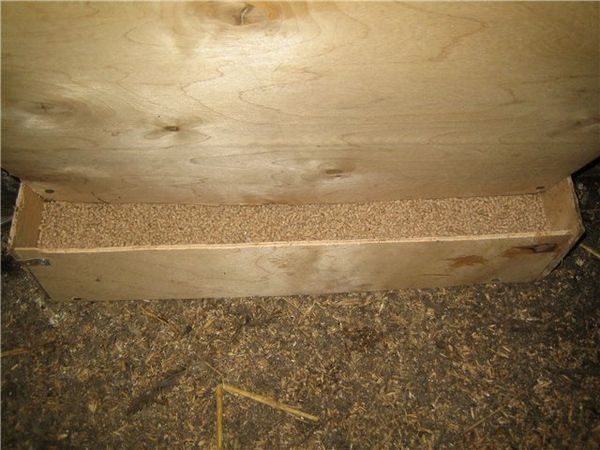
Instead of slats, you can take any cuttings from inventory, such as shovels. Attach on both sides of the need so that it rotates easily around its axis. This is necessary in order to make it difficult for chickens to sit on the feeder and keep their balance.
It should be considered: it is advisable to use a wooden feeder in indoor areas in order to avoid wetting andmaterial damage. It is not suitable for wet food, as it complicates the work of the poultry farmer in cleaning it.
From metal mesh or rods
This version of the feeder is useful for greenery, because otherwise the grass will be dragged by chickens throughout the house. Feeding trough is in one place. To construct it, you just need to bend a welded metal mesh of small diameter into a ring and attach the ends to each other.
This trough has no bottom. But for strength, it is nailed to a wooden, plywood or any other plane.corresponding to the diameter of the ring. Top cover with something. This design makes it easy to throw away all the faded content and put fresh green mass. Naturally, it is not suitable for bulk feed, since it has a large cellular structure.
Homemade chicken feeders do it yourself
Chickens in the first days of life need to eat particularly well. If their number is small, the problem with containers for food is easy to solve. To do this, install one feeder. But if their livestock is more than a hundred, then very soon they will grow up and in order to provide normal access to the feed, it is necessary to install several feeders or one big one.
Bunker version of scrap materials
The easiest feeder for chickens can be made from an ordinary plastic bottle. The essence of the design is to cut several windows in one row so that the chicken can stick its head and peck off the food. To the side of the cut-out windows at an angle of 90 degrees, cut one or two smaller openings to the size of the bottle neck.
Cut the bottle, as shown in the figure is inserted into the hole. The result was a kind of watering can, through which the feed is filled.
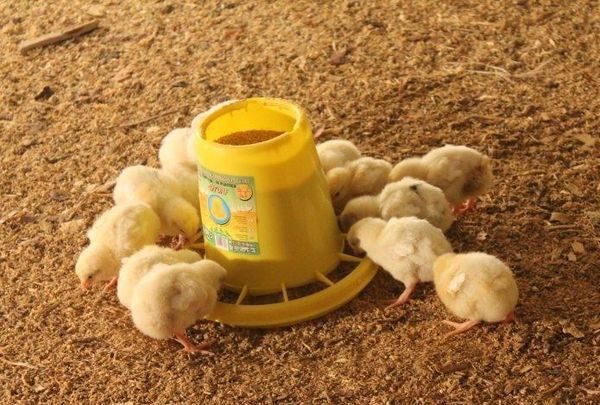
It is possible to suggest another option for the chickens bunker trough.
To do this, from any lightweight solid material (for example, the thinnest extruded foam) cut a circle in which holes are made along the contour so that the chickens can eat the food.
Cut a hole in the middle according to the diameter of the bottle or jar in which we fall asleep. Under the bottom we substitute any vessel (you can have a plastic bowl). With an inverted jar, grain is poured into the bowl as it is eaten.The diameter of the circle should be slightly larger than the diameter of the bowl.
If we take a glass jar as a bunker, then this design option has one major drawback - in order to fill it, you need to turn the jar over and fill it with compound feed. Then put on her foam circle, a bowl, and only then turn it all over and put it on the floor.
This design is suitable only for growing chickens., as the grown young or adult bird overturns the jar, and it can break.
Automatic feed for chickens
As a matter of fact, the automatic feeder is made in such a way that it’s no matter what it is and what it’s made of: a plastic bottle, glass, wooden, etc.) as the bird eats the grain, it pours into the container under the bunker (bowl , cell other).
Almost all of the above types of feeders are built on a bunker basis. This is an automatic feeder. That is, having poured the grain into the bunker once, for example, in the morning, the owner does not worry that you need to feed the bird in 3, 6 or 24 hours. When it is devastated, the bunker is again filled with food.
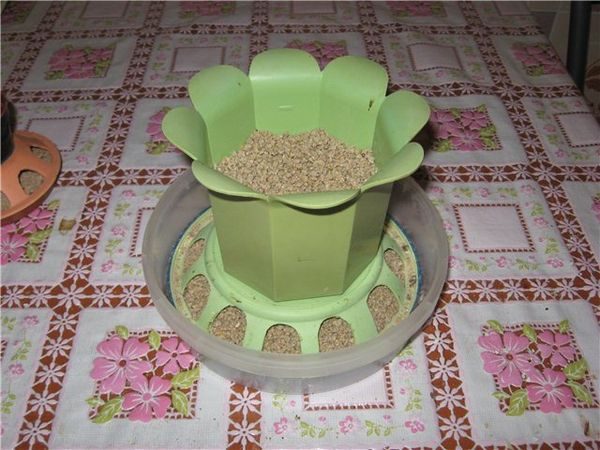
For its equipment you need only a bowl or disposable plastic dishes., depending on the size of the bunker itself (it could be a 20-liter bucket, or maybe an ice cream bucket).
In the bottom along the perimeter we cut small holes so that the food can be poured into the bowl when it is eaten. On top of this design is covered with a lid.
It can be made more mobile if you attach a handle to the design.
As you can see, the techniques of manufacturing feeders very much. We stop our choice on the basis of a specific situation: the number of heads of a bird, its age, conditions of detention, the availability of certain materials in the household, for what purposes it is grown (for example, if it’s broilers, then the bunker feeder (it’s also an auto-feeder) is simply irreplaceable , because broilers need to constantly eat, and from time to time during the day, feed the birds with enough trouble).
In addition, the feed itself also depends on the composition of the feed. For example, a metal or plastic feeder of an open type is better suited for a wet mash.Its easier to wash. For bulk feeds, the ideal option is bunker feeders. They ensure the dryness of the food inside it and its purity.
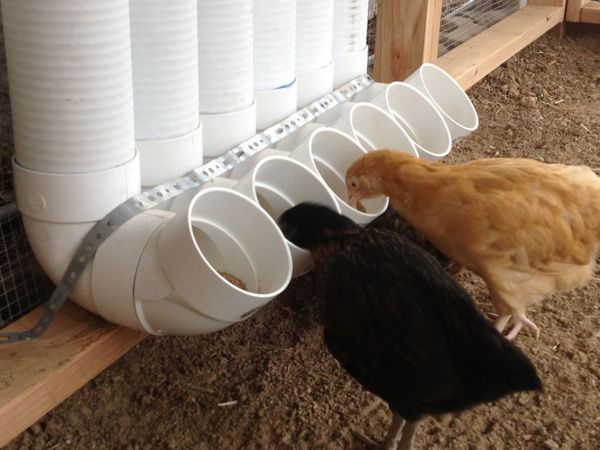
This is, of course, fascinating. But my grandmother told me that hen food should be limited. Like, you can not fill with a margin, especially if it is feed. Is it possible that the trough with automatic feed (dosyvaniem) will lead to the so-called overeating? As far as I know, this young growth suffers. Meat is not very tasty then ... Or are these all my stupid thoughts?
Anton, overeating does not threaten the bird. In order for the bird to grow, it needs to eat. Feed the bird need exactly as much as it eats. Automatic feeders just provide it as much as necessary and as automated as possible.
I heard about such layers. That you need so much food so that they eat it for 15 minutes and so a couple of times a day. There is no sense to feed a lot.